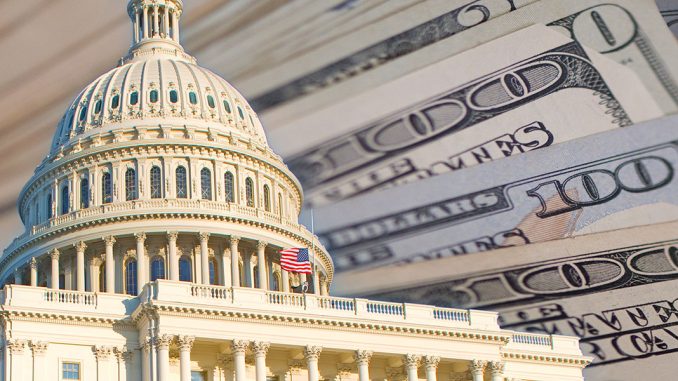
The bipartisan Tax Relief for American Families and Workers Act might sound good on the surface. A closer look, however, reveals that the legislation is gimmicky, fiscally irresponsible, and misses a chance to fix work requirements for welfare. And its business tax cuts include retroactive relief alongside pro-growth tax cuts.
To understand the gimmicky nature of how this bill would be “paid for,” imagine you hired a contractor to renovate your house for $80,000, but after a few years, the contractor had charged you $250,000. So you sit down with the contractor to figure out how to stop the financial bleeding.
“I can’t do anything about what I already charged you,” the contractor says, “but lucky for you I’ve found a way to work more efficiently going forward that will save you $80,000 of future charges.”
If you had the audacity to explain to your spouse that you can use that $80,000 of “savings” to hire another contractor to build a swimming pool, then you run your household budget just like congressional scorekeepers look at the federal budget.
But if you’re incapable of the mental gymnastics required to look at a scenario such as this and claim it demonstrates fiscal responsibility, I’m sad to say you just don’t have what it takes to work on the federal budget in Washington, D.C.
The scenario I described is analogous to what Congress is trying to do with this latest bipartisan tax cut and welfare expansion bill, which some tout as “fiscally responsible.” But instead of thousands of dollars, of course, substitute billions of dollars.
The tax cuts and welfare expansions in the bill supposedly would be “paid for” solely by stanching the flow of amended claims for the temporary employee retention credit, a credit that expired in 2021.
Only Congress could create a program with cost overruns that are at least triple the original projected lifetime cost, then use “savings” on the program to fund a new round of legislation.
In 2020 and 2021, Congress created and then expanded the employee retention credit, which taxpayers could claim for the 2020 and 2021 tax years. The total combined price tag, according to budget scorekeepers, was supposed to be about $77 billion.
The employee retention credit was meant to incentivize businesses to keep employees on payroll in the face of government shutdowns and supply chain issues during the pandemic.
But relatively few employers applied for the credit initially, perhaps because it wasn’t widely known or understood. However, after the credit supposedly expired in 2021, it became popular retroactively and a cottage industry sprang up to help employers apply for the federal program.
In 2022 and 2023, the Internal Revenue Service was flooded with amended returns claiming the employee retention credit. By September 2023, the IRS already had processed $230 billion in such claims.
The IRS is still sitting on a backlog of over a million claims that will push the total cost of the program even higher. Some claims are legitimate, but a large portion are dubious and outright fraudulent.
The IRS finally put a moratorium on such amended claims late last year.
The House’s tax and welfare bill would officially change the deadline to file amended claims for employee retention credits to Jan. 31, 2024—moved forward from April 2025. It also would add penalties and disclosure requirements to clamp down on the “ERC mills” that have exploited the program.
Government scorekeepers estimate this change would save about $78 billion, which is more than the entire program was supposed to cost in the first place.
It’s great that the government finally wants to put a stop to scams using the employee retention credit. But lawmakers shouldn’t claim to be fiscally responsible when they turn around and use this “savings” to “pay for” a mix of new welfare, legitimate tax cuts, and corporate giveaways.
The national debt is, after all, over $34 trillion, and the government is running annual shortfalls of $2 trillion.
Imagine if your family was $34 million in debt and falling $2 million further in debt each year. Even if you came by a legitimate $80,000 windfall, would you spend it or would you save it?
Or might you use it to increase your income to help repay the debt? The pro-growth parts of the bill could help do that, but unfortunately these provisions are overshadowed by other provisions in the bill.
The bill uses the employee retention credit “savings” for welfare and is light on actual tax cuts for individuals. According to estimates by government scorekeepers, 91% of the so-called individual tax relief in the bill consists of cash payments to people with zero income tax liability.
In fairness, some of this dynamic was true of the 2017 Tax Cuts and Jobs Act, but it’s disappointing that instead of fixing the problems this bill would just push more money out the door.
On the business side, some of the tax cuts are beneficial and pro-growth, but many of the changes are merely retroactive tax relief that would do little to grow the economy.
If Congress is going to use money it imagined into existence, it should be more prudent—especially at a time when inflation and mortgage interest rates are crushing the American middle class.
But words such as “prudence” and “fiscal responsibility” mean something different to the people who control the government’s $6 trillion budget than they mean to you or me.
Have an opinion about this article? To sound off, please email letters@DailySignal.com, and we’ll consider publishing your edited remarks in our regular “We Hear You” feature. Remember to include the URL or headline of the article plus your name and town and/or state.

